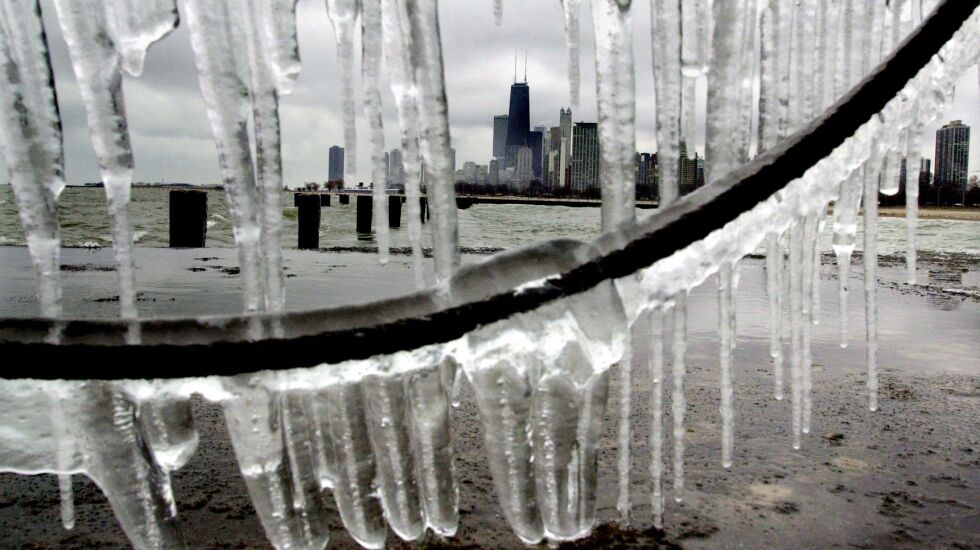
The temperature plunged to well below zero. As happens in Chicago, where constantly changing weather is a driving force in city life.
Sun-Times photographer Al Podgorski went to his favorite spot on the lakefront to capture the steaming skyline. As he snapped the frosty cityscape, a rogue wave from the lake leapt the breakwall and soaked him, head to toe.
“Super cold,” he remembered. “Totally soaked. My pockets were filled with water” — and expensive camera lenses.
By the time Podgorski hurried into a nearby building, “everything was frozen,” including his hair. He ran into a bathroom, hit the hand dryer and held his Nikon lenses, one by one, under the hot air to dry them. His hair would have to wait. The equipment had to be saved.
“We didn’t want the wrath of our bosses,” Podgorski said.
In the 75 years since the Sun-Times was founded, an anniversary being commemorated all this year, no story has been as consistent as the mercurial Chicago weather. From polar deep freezes to scorching summer noons — plus howling blizzards, flash floods, killer tornados and the rare gorgeous spring day, not to forget March’s entrance like a lion and exit like a lamb — no other topic has been as personal or carried as much practical importance to readers as the weather.
And no story was as consistently challenging to the newspaper’s reporters, editors and especially photographers, as the struggle to capture what it’s like outside, to find the wonder in ordinary meteorological events and to bring the rare and extraordinary to the readers’ doorstep.

“I was the ‘weather guy,’” Podgorski said. “Weather was my thing. I was always shooting weather. I would come back with weather pictures when nobody could find them.”
A “weather picture” is that elusive blend of whimsy and observation, conveying with power and immediacy: It’s cold. It’s windy. Or hot. Children always help here — cooling off in city hydrants, leaping into piles of autumnal leaves, flying kites, bundled up on sleds, making angels and snowmen.
“There were times when you had to find a weather picture,” said Rich Hein, who’s been on the Sun-Times photo staff for 38 years.
“Often, the assignment desk editor would say, ‘On your way in, if you see a weather picture, that would be great.’ But that’s not the way it worked; you had to actually look. It was easy to find a routine weather feature. I would spend hours looking for a good weather feature. We drove around a lot. I would go into the neighborhoods, look for kids in swimming pools, under a bucket of water, under a sprinkler. I tried to find something with some humanity in it.”
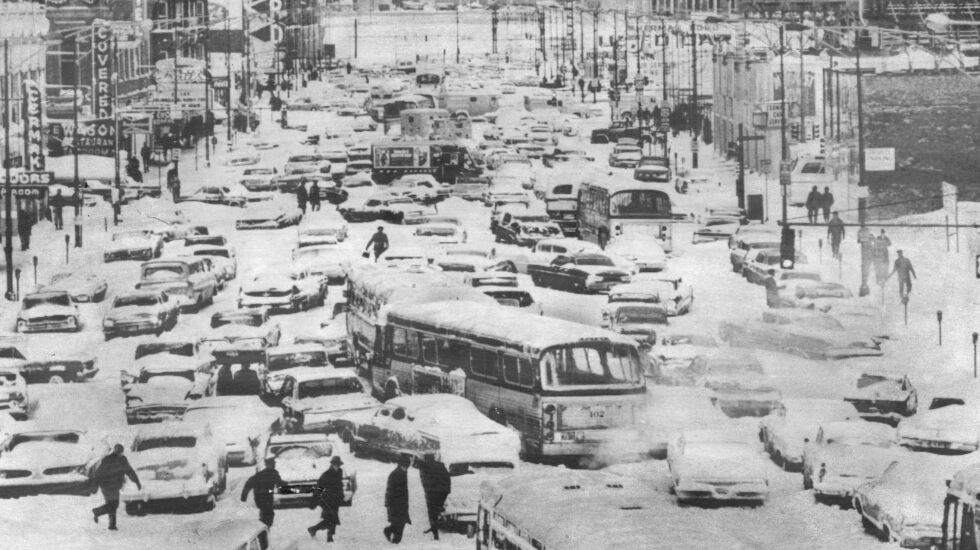
The right moment could also convey the urgency of dramatic weather stories, carved into our collective memory. For the January 1967 blizzard, photographer Bob Langer snapped a postal worker pulling his mailbag on a sled. Despite their “Neither snow nor rain...” slogan, mail delivery was suspended. Covering the news was not. Reporter Alex Katz skied to work during that massive snowfall and wrote a story about it, noting the trip in — on downhill, not cross country, skis — took two hours, while the bus trip home took more than three.
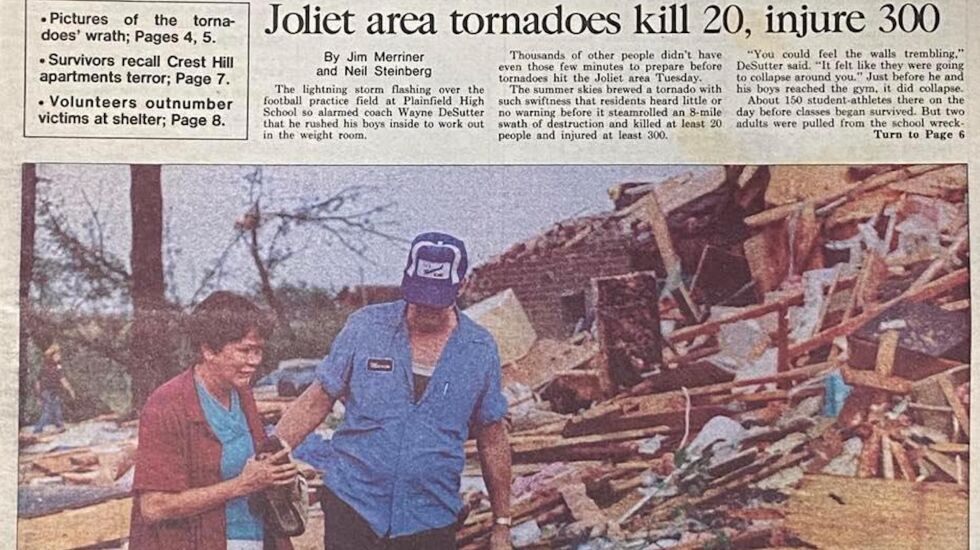
In late August 1990, photographer Bob Davis was in Joliet, covering a high school tennis match, when he was ordered to get himself to Plainfield. A surprise tornado — rated F5, the most powerful ever to hit the United States in August — had devastated the town. Davis arrived with the first responders and noticed Dorothy Walker holding her son Tony’s shoe, crying out his name, searching for him in the wreckage of the Crest Hill Apartments.
“The woman cradled the shoe like a small child,” Davis recalled. While Davis raced to get his film back to the paper, more photographers and reporters poured in, including me. What I remember most about that day was the sky — it was green — and sleeping on an army cot in a kindergarten room so I could be at the ruins of the Crest Hill Apartments at dawn the next morning.
There, I surveyed the cornfield where the rubble and a few victims — but not Tony Walker, who survived — were blown and heard an electric alarm clock, cast among the cornstalks, beeping — the harbinger of a normal day that would never be. It was chilling.
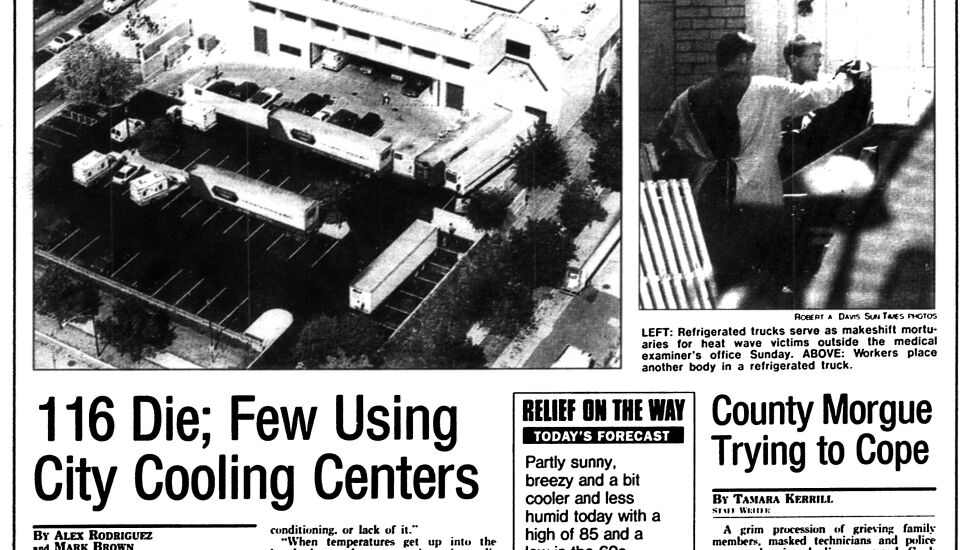

While weather disasters are treated with gravity, the usual annual extremes are cast in a light-hearted glow, almost a pride. But when to make the pivot is not always clear. The Sun-Times, like the rest of Chicago government and media, was slow to grasp the deadly impact of the 1995 mid-July heat wave — more than 700 people died, most elderly, alone in sweltering apartments that lacked air conditioning.
At least we didn’t offer up the Tribune’s shameful rebuke, a July 13 story that began, “Stop your whining. So what if it got up to 97 degrees ...” Five days later, Mike Royko, writing then for the Trib in what was not his finest moment, shrugged off the tragedy as a media invention: “Old people inevitably die of one thing or another.”
The next day, July 14, general assignment reporter Gil Jimenez was worried about his car overheating. So he took his motorcycle into the city for what would be, at 105 degrees, the hottest day in Chicago history.
“By late morning I began to notice more and more raised car hoods and stranded motorists,” Jimenez said. Most workers he found outdoors, bricklayers and bulldozer drivers, were at the point of throwing in the towel — a luxury that he couldn’t allow himself.
By the time Jimenez got back to the office, drenched in sweat, he was “dizzy, exhausted and sick to my stomach” and “more or less collapsed” on his desk. For a moment.
“The news goes on even if the reporters can’t,” he remembered. “So I did my best.”
We all do. During the “Snowpocalypse” of 2011 — when hundreds of people were trapped overnight on Lake Shore Drive — reporter Stefano Esposito decided he would walk home from the newsroom and interview people along the way.
“It was a stupid idea,” he said now, of what would have been a six-mile walk to Uptown. “I got about as far as North Avenue Beach. The snow was coming down so hard and fast.” Thankfully, he found a cab.
Art Golab was a young reporter covering a flood in Orland Park in February 1997 when he found a subdivision of homes cut off by water up to his waist. He called the city desk on his Motorola brick phone and asked for instructions.
“Some crusty editor ordered me to walk 30 yards through the freezing water,” said Golab who did what he was told even though he “never felt so cold in my life.” He “talked to a couple of people, but by the time I got back to my car, I was shivering uncontrollably.”
It’s easier when you have time to plan. In the 1990s, the Mississippi River started flooding regularly, and teams of reporters and photographers were sent Downstate to capture the scene of people desperately trying to save their levees. I made three such trips, and on one I had the presence of mind to stop by a Walmart and buy a pair of chest-high fishing waders, perfect for following managers into flooded office buildings.
Occasionally, a crisis demanded reportorial duties be set aside. Davis and I helped a retired coal miner push open the front door to his home that had become blocked by furniture floating against it. Podgorski and I came upon a regal stone house, the “Rock House” near Ste. Genevieve, Missouri, now surrounded on three sides by the swollen Mississippi River. Dozens of people turned out, filling sandbags, and we joined the sandbag line. I remember looking at this hastily-constructed sandbag and plastic wall — 15 feet high — and thinking, “If this gives way, we’ll all die trying to save this guy’s mansion.”
Sometimes, we can’t help offering some constructive advice. Photographer Ashlee Rezin was taking some shots of a raging lakefront in 2021 when a jogger too close to the edge was almost washed away by a wall of water.
“I was shooting it, holding my breath,” she said. “I thought, ‘I’m about to witness somebody get swept into the lake.’ I yelled at him — I wasn’t polite about it: ‘Don’t do that again! You’re f------ lucky. You’re an idiot! People die!”
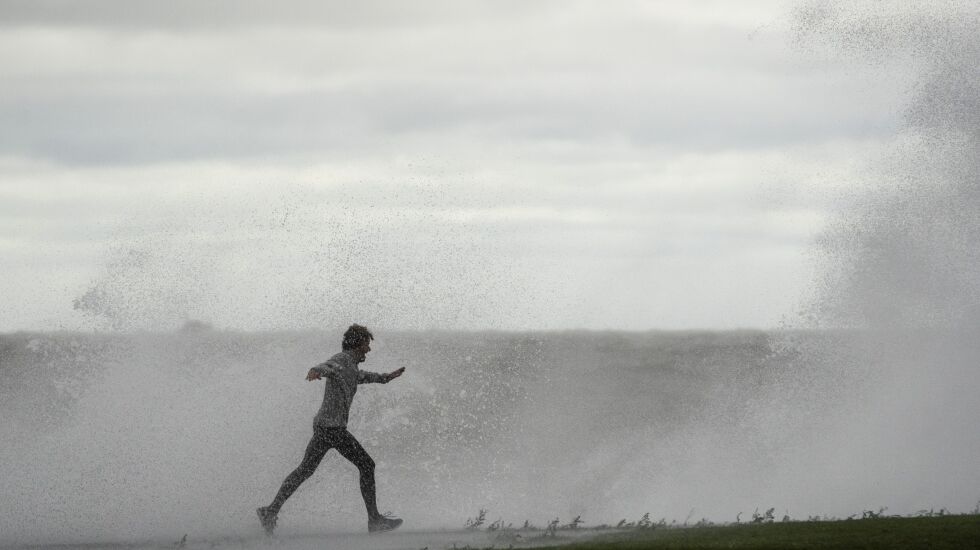
Not everything was frantic. In Grafton, I took a small boat down the main drag to the local tavern. The power was out, but they had beer on ice, and when a local offered to buy me one, I noticed his wallet was neatly secured in a Baggie, a trick that staff photographers also use to protect their equipment.

For Chicagoans, the most memorable flood wasn’t a meteorological event at all — it was the Loop Flood of 1992 that shut down downtown and was the result of a cracked portion of the Chicago River collapsing into the abandoned freight tunnel below. It cost billions, but most Chicagoans never saw the flood waters, never mind got wet. Nobody died.
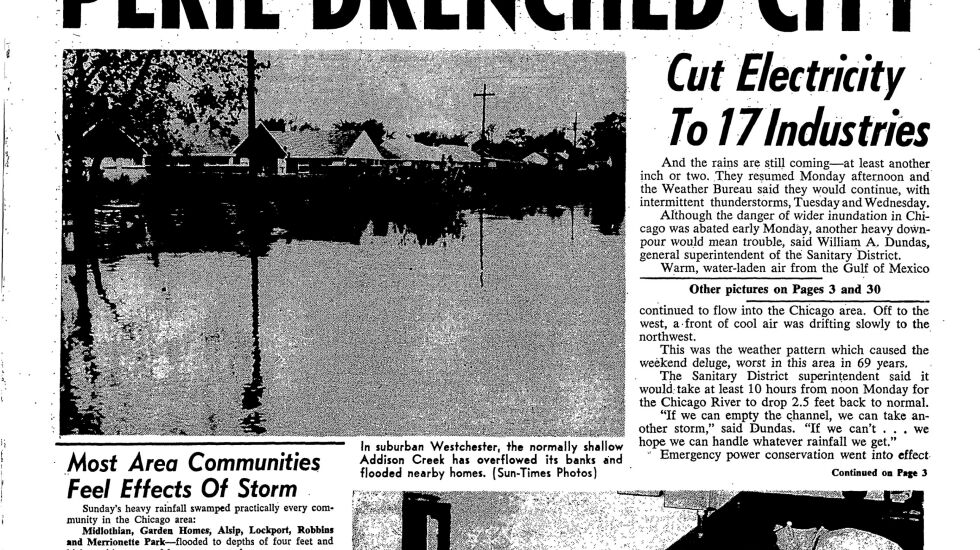
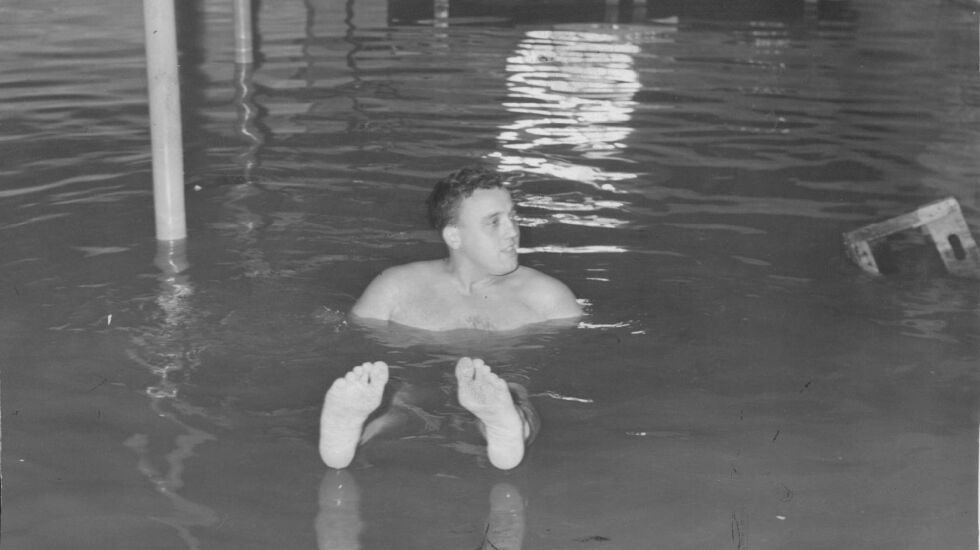
That wasn’t the case in the “Big Rain” of October 1954, where the Chicago River crested its banks. A quarter million dollars worth of newsprint was spoiled in the basement of the Chicago Daily News. For the first time since the river was reversed in 1900, the Chicago River once again flowed into Lake Michigan after the Chicago Sanitary District’s chief hydraulic engineer opened the lake lock that had never been opened, un-reversing the river’s course. Nineteen people died — some electrocuted in their flooded basements.
The weather affected staffers who never left the office, challenging them to find meaning. An editorial board member questioned the decision to open the lake lock, which kept downtown high-rise basements dry but risked contaminating the whole city’s water supply, calling for an area-wide system that would see fruition with the Deep Tunnel.
“Elements do not follow boundaries,” an unsigned Oct. 12, 1954, editorial noted. “An overall, integrated drainage district with power to act on its own is the only answer.”
In 2014 and 2019, the arctic sent us Polar Vortexes — a term that would appear more than 200 times in the paper over the past dozen years. The paper not only reported what happened but warned and advised, no doubt saving more than one reader’s life.
As often as the weather itself was the story, on far more occasions, the weather was just another challenge to getting a story.

“You have to make investments in waterproof shoes, waterproof pants, waterproof gloves, obviously gear for your cameras,” said Rezin, who frequently shoots Bears games.
And still that is not enough, like in September, when rain poured down at the end of a game at Soldier Field.
“That was the worst rain I’ve seen in years at a Bears game,” she said. “The heavens opened up. No amount of rain gear would keep you dry. All you can do is laugh.”
She still was able to capture Justin Fields’ celebratory slide in the end zone.
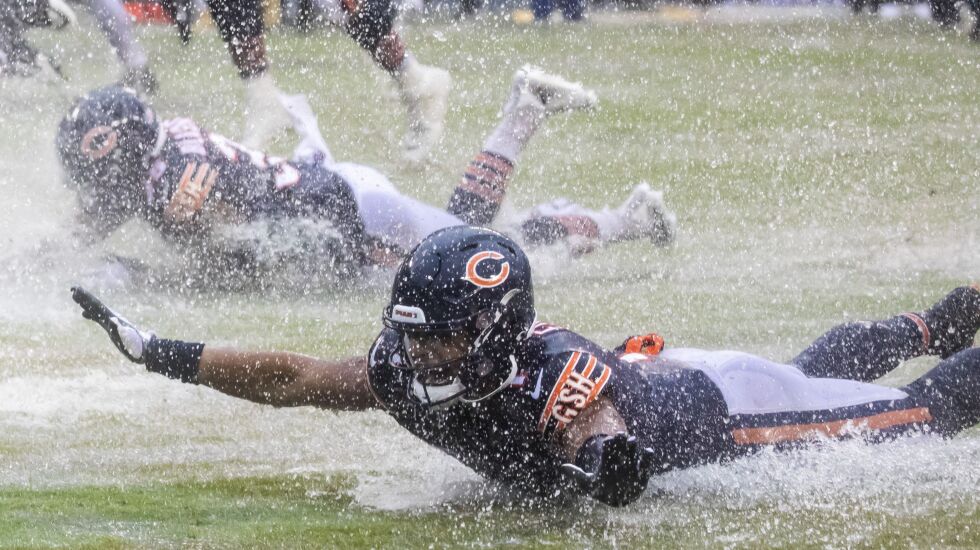
The monsoon-like rain of Aug. 8, 1988, was only significant because it was supposed to be the first night game under lights at Wrigley Field. Podgorski, shooting from the Cubs dugout, had one dry camera left when players joined the fans sliding on the tarpaulin.

Not to forget ordinary, quotidian weather, which for years the Sun-Times cleverly managed to turn into a popular front-page feature, the “Weather Word,” where Chicago’s complex, changeable meteorological environment was boiled down to a single term: “Anxious” or “Vivid” or “Optimistic.” Windy with scattered showers was “Gruff.” Pleasant, warmly and partly sunny was “Chippy.”
The Weather Word was the brainchild of executive news editor John Dodge.
“For years, in the top left corner, the Sun-Times always ran a short one- or two-word description of that day’s weather,” Dodge wrote in the Sun-Times in 2002. “I was tired of seeing the same boring words day after day ... sunny, cloudy, partly sunny, rain ...”
Dodge tried to never use the same word twice, and as happens with mandatory daily features, he soon found himself scrambling to feed the beast.
”Even my newborn son has helped,” Dodge wrote. “Etched on the fluffy white clouds of his crib bumper are words like: velvety, blissful and billowy. “Great weather words!” I thought one morning about 3 a.m., as I stared half-awake at Benjamin, sleeping peacefully (finally!) in his crib. ‘Thanks, son.’”








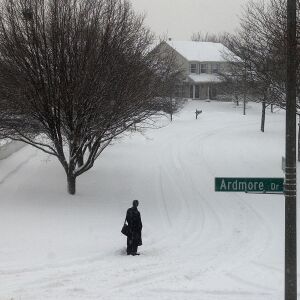

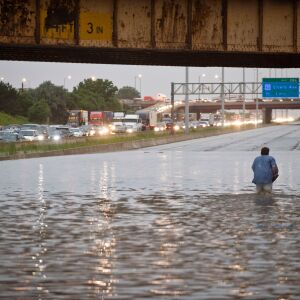
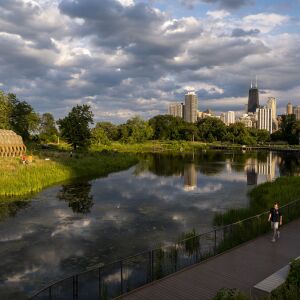
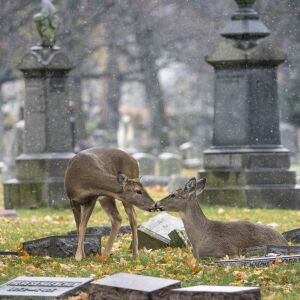
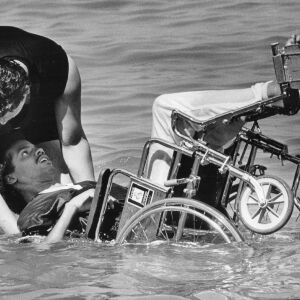








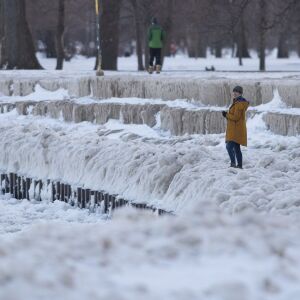
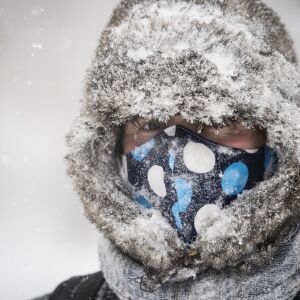



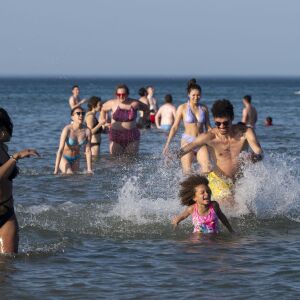
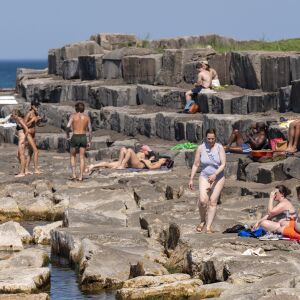

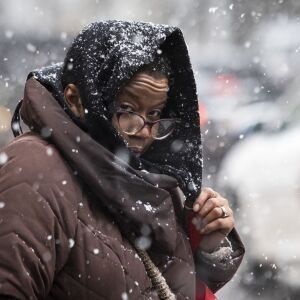



Through hail and sleet, snow and sun, for 75 years the Sun-Times has been the city’s rain gauge and thermometer. Trying to capture even a sliver of it, one truth stood out — the constant effort that went into doing the best we could.
”Something different, something you hadn’t seen,” explained Podgorski, describing the ideal weather photo. “You might see a mural on a the wall of a building, I’d park my car across the street, roll the window down and just wait for somebody to walk by with an umbrella. It might take half an hour.”
Then there was a certain puddle, years ago.
”I lay my camera down on top of a stone to get bicycles going through with the city in the background,” Podgorski said. “I must have taken 500 pictures of that, waiting for one frame. We developed the negative, and there was one that was really good, and of course the negative had a scratch in it. Years later, I got ahold of that negative and had it worked on, had the scratch removed digitally. Even though it wasn’t run.”
Until now:










































